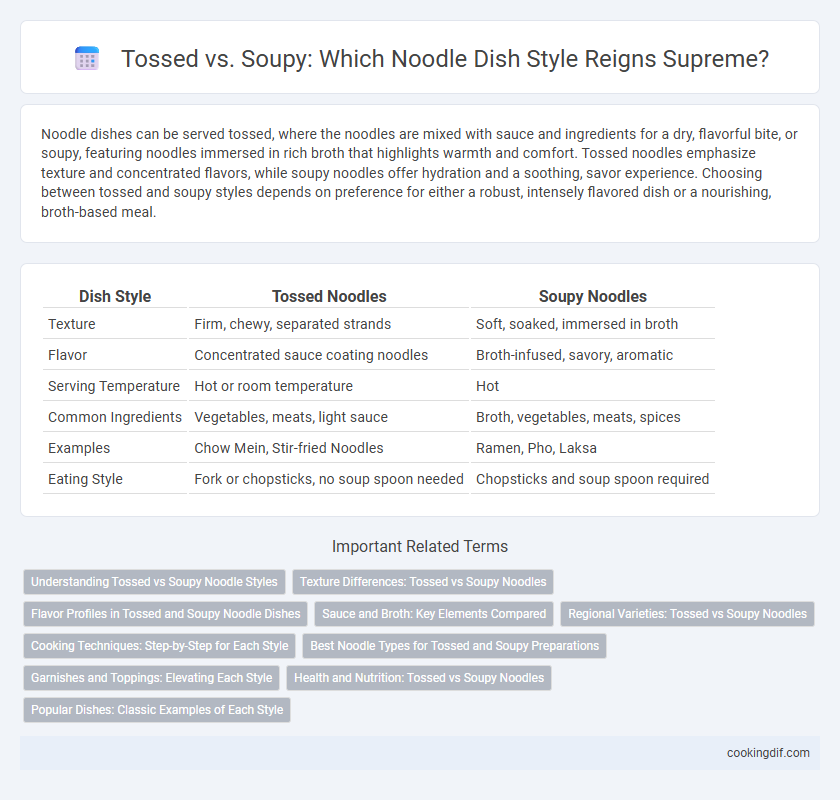Noodle dishes can be served tossed, where the noodles are mixed with sauce and ingredients for a dry, flavorful bite, or soupy, featuring noodles immersed in rich broth that highlights warmth and comfort. Tossed noodles emphasize texture and concentrated flavors, while soupy noodles offer hydration and a soothing, savor experience. Choosing between tossed and soupy styles depends on preference for either a robust, intensely flavored dish or a nourishing, broth-based meal.
Table of Comparison
| Dish Style | Tossed Noodles | Soupy Noodles |
|---|---|---|
| Texture | Firm, chewy, separated strands | Soft, soaked, immersed in broth |
| Flavor | Concentrated sauce coating noodles | Broth-infused, savory, aromatic |
| Serving Temperature | Hot or room temperature | Hot |
| Common Ingredients | Vegetables, meats, light sauce | Broth, vegetables, meats, spices |
| Examples | Chow Mein, Stir-fried Noodles | Ramen, Pho, Laksa |
| Eating Style | Fork or chopsticks, no soup spoon needed | Chopsticks and soup spoon required |
Understanding Tossed vs Soupy Noodle Styles
Tossed noodles feature a dry texture with sauces or seasonings evenly coating each strand, providing a flavorful and firm bite that enhances ingredients like vegetables or proteins. Soupy noodles immerse the noodles in a rich, savory broth, creating a warm, comforting dish where flavors meld and the texture is soft and slippery. Choosing between tossed and soupy noodle styles depends on desired eating experience and regional culinary traditions, influencing noodle type, sauce consistency, and ingredient combinations.
Texture Differences: Tossed vs Soupy Noodles
Tossed noodles feature a dry, firm texture with each strand separate, enhancing chewiness and allowing sauces or seasonings to coat evenly. Soupy noodles have a soft, slippery texture as they soak in the broth, offering a smooth mouthfeel and a flavorful, rich experience with every bite. The choice between tossed and soupy impacts the noodle's bite resilience and overall dish consistency.
Flavor Profiles in Tossed and Soupy Noodle Dishes
Tossed noodle dishes feature intensified, concentrated flavors as sauces and seasonings cling evenly to each strand, offering bold and often spicy or tangy taste profiles. Soupy noodle dishes provide a rich, layered flavor experience where the broth's depth--from savory umami to aromatic spices--complements the noodles and ingredients, creating a harmonious and soothing palate. The contrasting textures between tossed and soupy styles also influence flavor perception, with tossed noodles delivering a dryer, more robust mouthfeel and soupy noodles offering moist, comforting warmth.
Sauce and Broth: Key Elements Compared
The sauce in tossed noodle dishes is typically concentrated and coats each strand, delivering intense flavor and a slightly dry texture. In contrast, soupy noodle dishes feature a broth that is rich, aromatic, and often simmered for hours to develop depth, providing a comforting and hydrating base. The balance between sauce viscosity and broth liquidity defines the overall mouthfeel and taste experience unique to each noodle style.
Regional Varieties: Tossed vs Soupy Noodles
Regional varieties of noodles emphasize distinct styles, with tossed noodles commonly favored in Chinese and Southeast Asian cuisines for their dry, flavorful coatings and varied textures. Soupy noodles dominate in East Asian regions like Japan and Vietnam, where broths infused with regional spices and ingredients create rich, aromatic dishes. Each style reflects local preferences and ingredients, offering unique sensory experiences through either concentrated sauces or hearty, comforting soups.
Cooking Techniques: Step-by-Step for Each Style
Tossed noodles require precise stir-frying techniques to evenly coat each strand with sauce and maintain a firm texture, ensuring the dish remains dry and flavorful. Soupy noodles involve simmering noodles directly in broth, emphasizing controlled boiling and timing to prevent overcooking while allowing the noodles to absorb the savory liquid. Mastering these methods enhances the dish's texture and taste, highlighting the distinct characteristics of tossed versus soupy noodle styles.
Best Noodle Types for Tossed and Soupy Preparations
Ideal noodle types for tossed dishes include thin egg noodles, rice vermicelli, and soba, known for their ability to absorb flavors without becoming soggy. For soupy preparations, udon, ramen, and rice noodles excel by maintaining texture and complementing rich broths and hearty ingredients. Choosing the right noodle enhances the dish's overall balance, texture, and taste based on the cooking method and sauce or broth consistency.
Garnishes and Toppings: Elevating Each Style
Tossed noodle dishes showcase vibrant garnishes like fresh herbs, crunchy peanuts, and toasted sesame seeds that add texture and brightness without overwhelming the palate. Soupy noodle bowls emphasize toppings such as soft-boiled eggs, sliced scallions, and marinated meats, which infuse the broth with rich flavors and create layers of taste. Strategic use of garnishes and toppings elevates both styles by balancing freshness, aroma, and depth, enhancing the overall dining experience.
Health and Nutrition: Tossed vs Soupy Noodles
Tossed noodles typically have less broth, reducing sodium and calorie intake compared to soupy noodles, which often contain salt-rich broths that can increase sodium levels. The absence of excess liquid in tossed noodles helps preserve nutritional density by minimizing dilution of vitamins and minerals. Choosing tossed over soupy noodles can support better hydration balance and cardiovascular health due to lower sodium consumption.
Popular Dishes: Classic Examples of Each Style
Popular tossed noodle dishes include Pad Thai and Chow Mein, where ingredients are stir-fried with sauce to create a dry yet flavorful coating. Soupy noodle dishes like Pho and Ramen feature noodles immersed in a rich, aromatic broth that enhances the overall taste experience. Both styles highlight diverse textures and flavor profiles, appealing to different regional preferences and culinary traditions.
tossed vs soupy for dish style Infographic

 cookingdif.com
cookingdif.com